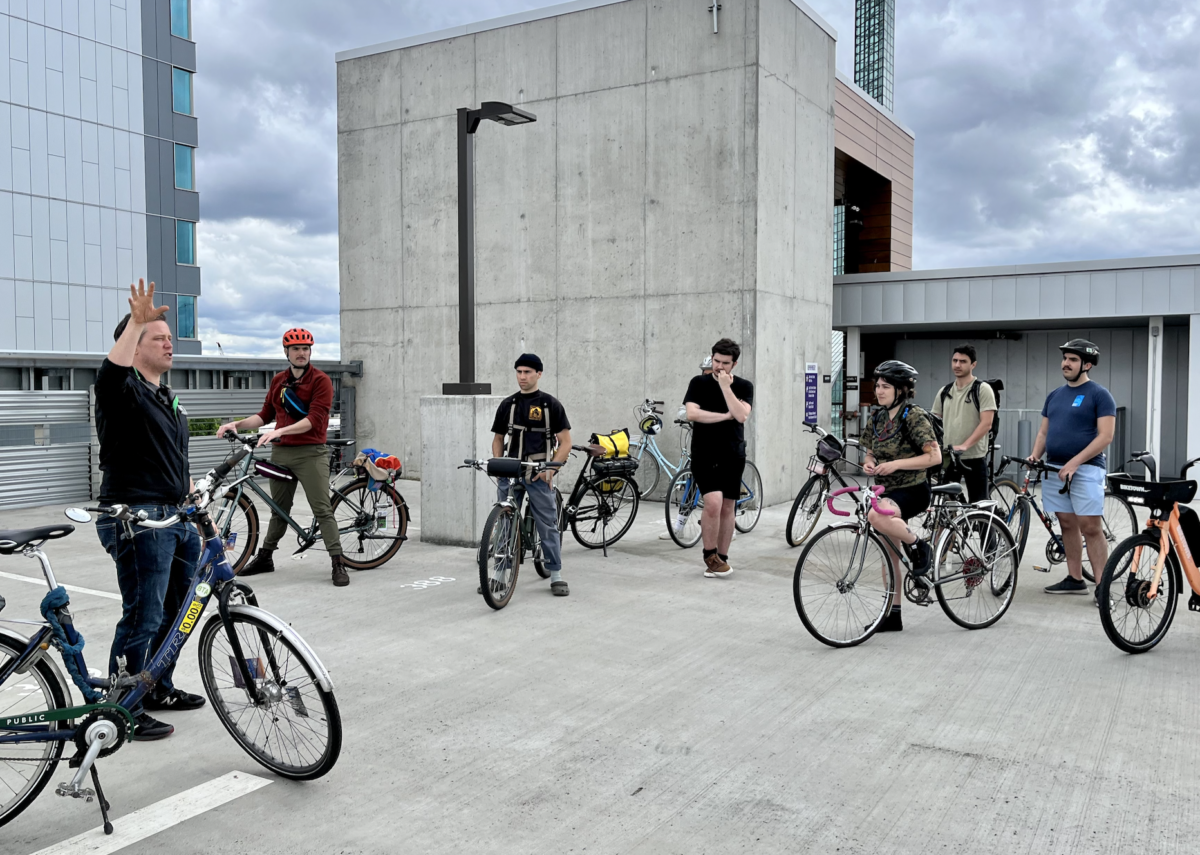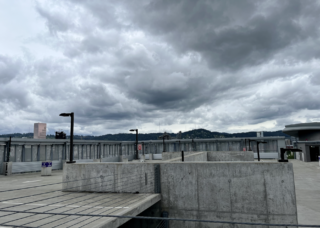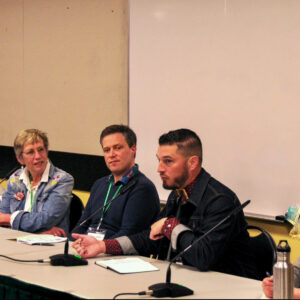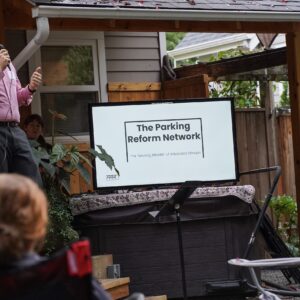
Car parking has a unique place in the modern American cultural zeitgeist. How often do you hear people brag about or bemoan their parallel parking skills or complain about the hellscape of the Trader Joe’s parking lot? Considering how much money and effort goes into planning and building parking structures and spaces, it makes sense how much we talk about it.
Despite its real estate in our brains, however, the average American hasn’t taken a real peek behind the parking curtain. On Bike Loud PDX’s latest policy ride hosted by their west chapter, local parking guru Tony Jordan aimed to share what lies beneath the asphalt surface of car parking in Portland.
In several stops throughout the central city, we toured facilities that have a total of nearly 5,500 car parking spaces.
Jordan presides over the Parking Reform Network, a Portland-based non-profit with a mission to educate the public about the impact parking has on our society and create policy change. Last Friday, he led a group bike ride around downtown and the Lloyd, taking participants on an odyssey of Portland parking history.
Advertisement
[Video below is a recap of the ride by Amit Zinman.]
I had some insight into parking policy going into the ride, especially after I heard Jordan speak alongside other parking experts at last month’s YIMBYtown conference. But it was a different experience to see how these plans play out in real life. As we made our way around downtown, Jordan told stories about how car parking has shaped big parts of Portland’s DNA.
One place in downtown Portland impacted by the ills of parking is O’Bryant Square, which used to be an open plaza park and is now a fenced-off slab of concrete taking up space. The Portland Bureau of Transportation shut the plaza down in 2018 citing structural issues with the parking garage under the park, which would take a few million dollars to repair.
“It’s not necessarily the city’s priority to spend the money to rebuild that parking. So, instead of a park, we have a fenced off broken parking garage,” Jordan said.
Jordan led us across the river where we rode to the top of the (mostly empty) seven story Oregon Convention Center parking garage on NE Multnomah St and 2nd Ave. You get a pretty nice view of the city from that vantage point, as well as a concrete playground to ride around in, but is that really worth the $32 million it cost to build and the space it takes up today?

Advertisement
Among the many problems building abundant car parking creates is the central fact that more parking encourages more driving. The parking garage at the convention center is a good example of that: it’s located right across from the Hyatt Regency, which is mostly a place tourists stay. This area is perfectly accommodated by public transportation: the MAX red line from the airport essentially deposits you at the hotel door. But if you took the MAX, who would fill up all those lonely parking spots?

“Along with the MAX at the airport, they also have a hell of a lot of parking and car rental facilities,” Jordan said.
Instead of further investing in public transportation and encouraging people to use the transit we already have, building parking garages incentivizes driving cars and makes it seem necessary to have a car to get around when it’s really not.
After circling back down the empty parking garage, we headed over to the parking lot near Holladay Park right across from the Lloyd Center, where Sightline Institute author Michael Andersen briefly took over to share how the Lloyd Center’s abundant parking lots came to be.

Mall parking lots are pretty much the same everywhere: miserable mazes full of annoyed shoppers desperate to find the perfect place to store their car. Andersen shared a very interesting theory on the mall in American society as places where people can take a short respite from cars and pretend they live in walkable cities where the streets are lined with shops. He said malls are little villages “constructed in the middle of a circle of parking lots” that people drive to, park their cars, have fun in the mall and then drive home.
This ride was just a brief primer on parking policy in Portland, and there’s a lot more information lying beneath. But even a two hour policy ride has the power to open someone’s eyes to how much stock our city puts into parking and how impactful it is on everyone’s lives, even people who don’t drive cars.
The big takeaway? We don’t need more parking. And the more we build, the more we encourage people to continue driving cars.
“There’s enough parking that already exists to manage the demand we have now,” Jordan said. “So if you think the traffic we have right now should get worse, you should support more parking. If you think the traffic we have now is bad enough, then we do not need more parking! We already have enough.”
If you’re inspired to join one of Bike Loud’s policy rides throughout the city, keep an eye on our calendar or sign up for their monthly newsletter.







Thanks for reading.
BikePortland has served this community with independent community journalism since 2005. We rely on subscriptions from readers like you to survive. Your financial support is vital in keeping this valuable resource alive and well.
Please subscribe today to strengthen and expand our work.
That parking garage is so maddening to me! IN the face of all of our planning, climate goals, transit investments, housing needs: Metro builds a free-standing parking garage at basically the heart of the MAX system. To add insult to injury, I was suspected that Metro opted to build the parking here to keep the apparent cost of the hotel from being bigger. The obvious choice is to integrate the parking with the hotel in a basement (expensive) or forgo parking and rely on transit (too risky- Metro doesn’t actually believe their plans will work) so they build a free standing parking garage for the hotel. I honestly think it is scandalous.
Note: it’s Prosper Portland that built the garage as part of the whole Metro brokered deal to get the hotel built.
Makes sense, Prosper Portland always does find a way to make things worse
Side note: is the bike parking at Prosper Portland’s new parking garage available to use? Last time I went by the doors were locked with no obvious way for anyone to access the bike rooms (i.e. I couldn’t see any card readers).
Trader Joe’s lots are eminently rideable by a skillful old fixer.
Sorry, but I think your logic is just all wrong here. Let me try to summarize the argument:
“Parking lots are bad b/c they encourage driving. Ergo, if we no longer build parking lots, people will no longer drive.” But that’s just not the way people think.
I don’t know ANYONE who would follow that logic. Here’s how people actually think:
“I want some [insert name of modern consumer item or service]. What’s the easiest way for me to get it? Oh, by driving my personal car, of course. Let’s see: What places make it easiest for me to drive my car? I’m not going to drive to [insert name of business or area that lacks easy and car convenient car parking]. Instead I’m going to drive to [insert name of business or area with easy, plentiful, and convenient car parking – as close to the destination as possible].”
That is actually the way people think. For your logic to work, people would need to interrupt their current way of thinking, like this:
“I want to drive my personal car to [x]. Oh wait – there’s no parking at [x]. Well then, I’ll just [take the bus OR rent a Nike Bike OR hitchhike].”
In other words, the argument depends on people making the leap to some OTHER mode of transportation, which people simply do not do.
Now, I’m sure you’ll counter that if enough cities, counties, and other municipalities PROHIBIT the building of parking lots and structures, then people will be FORCED to get there by means other than driving. But then the availability of parking REALLY becomes a competitive advantage for the places that have it. You’ll have a race to the bottom, as people drive further to reach far-flung places that still offer parking.
Attacking parking lots is like putting a cold compress on your head when you have a fever: makes you feel better but does nothing to address the CAUSE of the disease. We have to make it as easy and attractive to take the bus, ride a bike, etc as it currently is to drive a car everywhere.
If we are investing in parking and car-centric infrastructure then we are making it very difficult to “make it as easy and attractive to take the bus, ride a bike, etc as it currently is to drive a car everywhere.”
This is due to two things, one is theoretically solvable and the other is a physical reality.
Money – if we spend $32M in future tax revenue on a parking garage next to a MAX station, we aren’t spending $32M on transit, bike, and pedestrian infrastructure. If we spend $25M to retrofit a parking garage, we aren’t spending that $$ on efforts to help people drive less. Sure, we COULD spend money on both, but we know how that is going to go.
Space – The space we give to cars competes with space for other modes. A parking garage necessitates egress and entrance. Those make certain bike and transit and walking infrastructure less efficient or impossible. You can’t close a street to cars if there’s a parking garage exit on it. Additional parking invites additional driving which means more traffic which means less space for bus lanes, bike lanes, etc and more conflict and danger for those who do choose to ride. Sure, you can believe we’re going to build tunnels for all the Teslas, but let’s get real, car first development is incompatible with good transit and multi-modal infrastructure.
Lastly, there is lots of evidence that yes, people do in fact make choices based on parking pricing and availability (which are linked). Of course not EVERYONE is going to do any particular thing, but a place with a lot of parking is going to mostly encourage people to drive there and a place without it is going to have higher alternative mode shares. And there is plenty of evidence that places without a lot of driving share are more economically vibrant than places with it.
I disagree with your comment:
The actions are not linked in the way you describe. The existence of the parking lot doesn’t encourage anything; it simply enables people to do what they are doing already. The LACK of parking means that MOST PEOPLE – today, in 2022 – will not go there. For this reason it’s completely logical for businesses and other organizations to provide parking – it’s what most people currently want.
I’d recommend you and anyone else interested in human motivation read the work of Frederick Herzberg, who distinguished between motivating factors and what he called “hygiene” factors. They are two completely different, unconnected sets of factors! And I’d argue parking is a HYGIENE factor: it’s like heat and running water for most people nowadays.
If you want to motivate people to use non-car means of transport, you have to address the factors that actually motivate people to choose the ways they get around, like convenience, ease of use, effectiveness, culture, money, etc.
The existence of abundant and cheap parking, which I argue is provided at the expense of infrastructure and funding for other modes contributes to driving being the most convenient and sometimes effectively only option to many places. You can mince words, but this encourages, cements, whatever you want to call it; the status quo.
As I stated, and I note that you did not choose to address, improving the “facts that actually motivate people” is much more difficult if we encourage or require additional car parking.
There is enough parking to support our current traffic. If you want more traffic, build more parking.
There is far, far too much parking and traffic to avoid ecocide.
This is correct. You can build a giant city w/o cars, but will need to build a giant parking garage right next to it for anyone to visit.
Instead of hating cars, parking…we need to create non-car spaces and travel. Car free business zones will need service to get folks there. USE ALL MODES. Protected bike lanes, bus only lanes and yes, large parking garages at the outskirts of those areas.
Plus, folks are buying bigger and bigger bikes…3 and 4 wheelers too. Parking and pathways are needed for all, not arguments about one mode or the other.
I gave up helping out with some of these efforts once I realized that the advocates who wanted zero parking for new construction (which lowers cost, and makes the units attractive to anyone…even those with cars) would simply push those cars to the street. Yet, bike/bus lane advocates realize we should convert on-street parking to…bike and bus lanes (lots of good data about the benefits for all too).
We really should have parking so that streets can be used for transit. End of debate really. But the advocates can’t see beyond their own singular issues it seems.
Not sure what you mean by “have parking so that streets can be used for transit” (I take it “transit” means “general use,” not public transit like Trimet). But you hit the nail on the head about housing and parking: building housing w/o parking does NOT mean people won’t have cars. We have to address WHY people feel they need to own cars. Where they choose to store them is an ancillary issue. I’ve lived in many places that did not have parking for my car but I chose to own one anyway and still do. I also have a bike – actually many bikes – and choose to use them as often as possible. Why is that? – that’s the kind of issue we should be investigating, not hating on parking.
Did you forget about regional transit systems? Have you never traveled to other cities before? These aren’t problems that need solving. Cities can exist without cars.
Don’t know about that , Mo. Take Manhattan, it’s got a population of about 2 million at night, and about 4 million in the day. That’s the bridge and tunnel crowd, every weekday, in and out. By train.
I’ve always taken a train to get into big cities, unless I’m flying.
No, Lisa – that’s an oversimplification. Manhattan is always held up as a car-less utopia, but even there almost 25% of residents own cars (https://edc.nyc/article/new-yorkers-and-their-cars). And many thousands more commute into New York daily by car and then out again by car. Cars are a HUGE part of life in NYC, though I wish they weren’t.
Hey Fred. I lived in NYC for a decade, Manhattan and Queens. (And the tri-state area for almost another decade.) We had a car in Queens, and I drove the precious bundle to daycare every day on the BQE (Brooklyn-Queens Expressway, not for the faint of heart) so I know of which I speak. It’s not car-free, and it’s definitely not a utopia, but you don’t take a car into Manhattan w/o a very good reason. Manhattanites who own cars usually use them to get out of the city on weekends.
Nights and weekends are easier, and you can usually find street parking.
I enjoy going to the waterfront downtown, and I enjoy visiting my friends on the East side and going to a new restaurant that just opened. These are destinations that are a fix point. If driving is faster and parking is easier, I will take that option. But never is it “Oh I can’t visit my friends because parking sucks”.
Here’s a corollary to this: When I want to go buy fresh veggies and small-farm-raised meat on a Saturday morning at the PSU Farmers Market, I drive my car because these are the options:
If you want to make it harder to park by the PSU market, I mean, that’s cool. The calculus doesn’t change to “Maybe I’ll take MAX.” The calculus changes to “I won’t go to the market anymore, I’ll just drive to the Happy Valley New Seasons instead.”
So to pile on to what Fred said, I really wish the parking advocates would focus on increasing access to amenities to a greater footprint of the city, rather than just scolding people who don’t live near the amenities and need to (not choose to – because I think we can reasonably say that the choice between a 45 minutes and a 115 minute commute is not a choice, especially if you have a family that might appreciate your presence back at the ranch) drive to get access to those amenities.
“But you could also just downsize your life and move closer to the city,” one might say. And that’s true! But then you’re talking about a colossal wealth shift that would require a bunch of people to vote against their own economic interests by essentially draining single family housing of its residents, and that seems highly unlikely.
TL;DR: Either speed up transit, or make more places where amenities are available, or accept that this is reality and the anti-parking crusade isn’t transformational, it’s an isolationist effort to keep people who don’t live “your” lifestyle out of “your” city.
50% of people living in Amsterdam have cars.
The issue is not about cars.
It’s about protected bike lanes.
That’s it. Build them and everything changes.
Stop hating the wrong things.
I agree, Jim, yet I’ll continue hating protected bike lanes also. They are not the right thing – at least not the way we are building them.
But you’re on the right track here. Thanks.